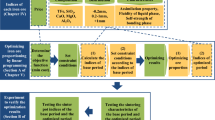Abstract
An ore-blending optimization model for the sintering process is an intelligent system that includes iron ore characteristics, expert knowledge and material balance. In the present work, 14 indices are proposed to represent chemical composition, granulating properties and high temperature properties of iron ores. After the relationships between iron ore characteristics and sintering performance are established, the “two-step” method and the simplex method are introduced to build the model by distinguishing the calculation of optimized blending proportion of iron ores from that of other sintering materials in order to improve calculation efficiency. The ore-blending optimization model, programmed by Access and Visual Basic, is applied to practical production in steel mills and the results prove that the present model can take advantage of the available iron ore resource with stable sinter yield and quality performance but at a lower cost.
Similar content being viewed by others
References
R. Bergstrand, J. Khosa, A. Waters, et al., The effect of marra mamba ore addition on the granulation characteristics of pisolite based and hematite based sinter blends, ISIJ Int., 45(2005), No.4, p.492.
C.E. Loo and D.J. Wong, Fundamental insights into the sintering behaviour of goethitic ore blends, ISIJ Int., 45(2005), No.4, p.459.
J. Okazaki and K. Higughi, Marra mamba ore, its mineralogical properties and evaluation for utilization, ISIJ Int., 45(2005), No.4, p.427.
X.L. Yuan, X.H. Fan, X. Wan, et al., Design and application on calculating iron ores matching model, J. Chongqing Univ. Sci. Technol., 11(2009), No.3, p.73.
Q.Z. Niu, H.Z. Ye, and Y.F. Wu, Design of a mine blending expert system for sinter plant, J. Gulin Inst. Technol., 22(2002), No.4, p.391.
L.H. Wu and X.F. Chen, Research and optimization on factors influencing the mix granulating in Pangang sintering plant, Sintering Pelletizing, 31(2006), No.1, p.19.
S.L. Wu, Y. Liu, J.X. Du, et al., New concept of iron ores sintering basic characteristics, J. Univ. Sci. Technol. Beijing (in Chinese), 24(2002), No.3, p.254.
H. Kimura, T. Ogawa, M. Kakiki, et al., Effect of Al2O3 and MgO additions on liquidus for the CaO-SiO2-FeOx system at 1573 K, ISIJ Int., 45(2005), No.4, p.506.
N. Oyama, H. Sato, K. Takeda, et al., Development of coating granulation process at commercial sintering plant for improving productivity and reducibility, ISIJ Int., 45(2005), No.6, p.817.
J. Khosa and J. Manuel, Predicting granulating behaviour of iron ores based on size distribution and composition, ISIJ Int., 47(2007), No.7, p.965.
M. Matsumura and T. Kawaguchi, Effect of moisture distribution of sinter mixture on granulating particles, Tetsu-to-Hagané, 87(2001), No.5, p.290.
S. Sato, M. Yoshinaga, M. Ichidate, et al., Consideration on the granulation and the bed-permeability model of sinter raw materials, Tetsu-to-Hagané, 68(1982), No.15, p.2174.
E. Kasai, S.L. Wu, and Y. Omori, Influence of property of iron ores on the coalescing phenomenon of granules during sintering, Tetsu-to-Hagané, 77(1991), No.1, p.56.
E. Kasai, S.L. Wu, and Y. Omori, Factors governing the strength of agglomerated granules after sintering, ISIJ Int., 31(1991), No.1, p.17.
Y.D. Pei, Ore Proportioning during Sintering and its Application Technology [Dissertation], University of Science and Technology Beijing, Beijing, 2008, p.50.
Y.M. Dai, Research on Expertise System of Ore Blending Optimization with Good Sintering Indices and Low Sintering Cost [Dissertation], University of Science and Technology Beijing, Beijing, 2009, p.47.
S.L. Wu, J.X. Dun, H.B. Ma, et al., Fluidity of liquid phase in iron ores during sintering, J. Univ. Sci. Technol. Beijing (in Chinese), 27(2005), No.3, p.291.
D.Q. Jiang, J.K. He, and S.H. Chen, Practically Linear Programming Method Including Supporting System, Tsinghua University Press, Beijing, 2006, p.2.
Author information
Authors and Affiliations
Corresponding author
Rights and permissions
About this article
Cite this article
Wu, Sl., Oliveira, D., Dai, Ym. et al. Ore-blending optimization model for sintering process based on characteristics of iron ores. Int J Miner Metall Mater 19, 217–224 (2012). https://doi.org/10.1007/s12613-012-0541-2
Received:
Revised:
Accepted:
Published:
Issue Date:
DOI: https://doi.org/10.1007/s12613-012-0541-2




